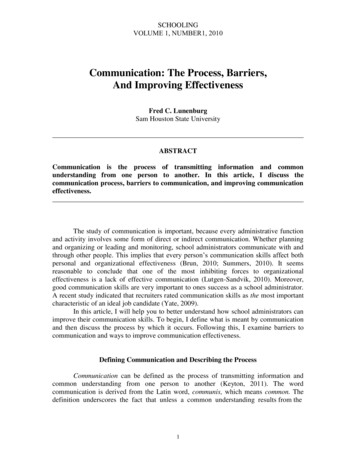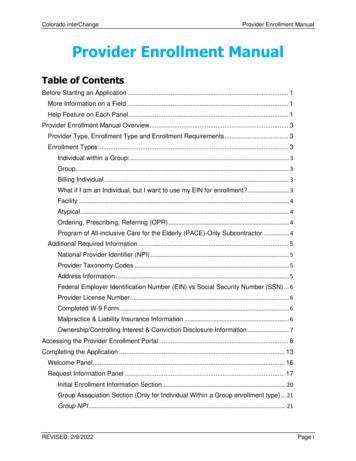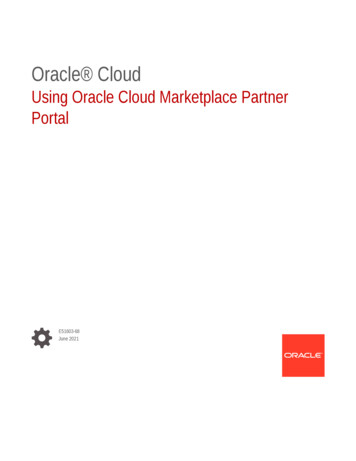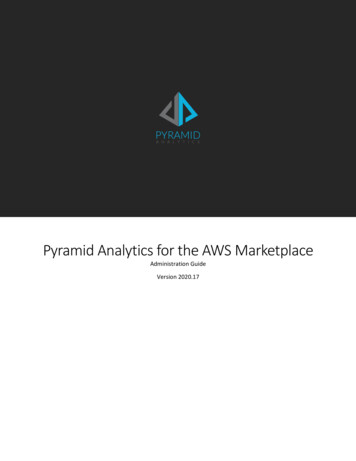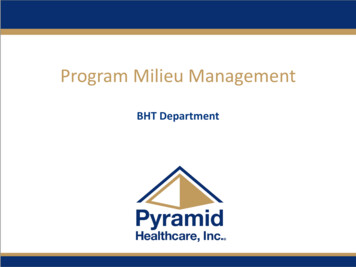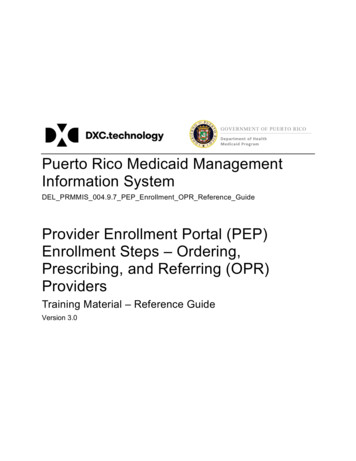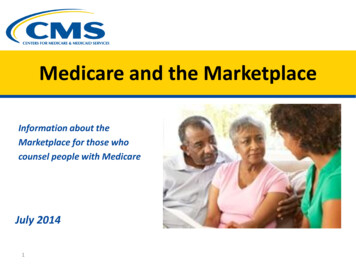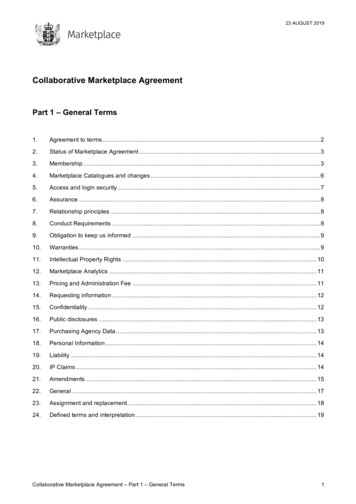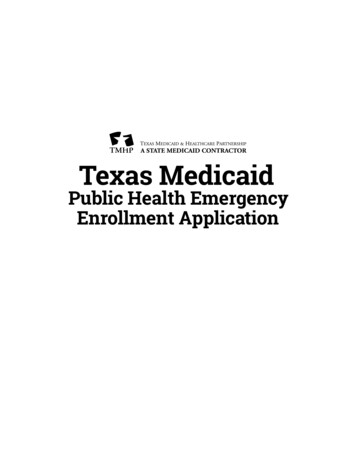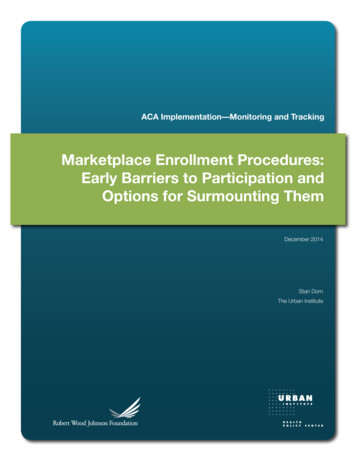
Transcription
ACA Implementation—Monitoring and TrackingMarketplace Enrollment Procedures:Early Barriers to Participation andOptions for Surmounting ThemDecember 2014Stan DornThe Urban Institute
With support from the Robert Wood Johnson Foundation (RWJF), the Urban Instituteis undertaking a comprehensive monitoring and tracking project to examine theimplementation and effects of the Patient Protection and Affordable Care Act of 2010(ACA). The project began in May 2011 and will take place over several years. The UrbanInstitute will document changes to the implementation of national health reform to helpstates, researchers and policymakers learn from the process as it unfolds. This report is oneof a series of papers focusing on particular implementation issues in case study states. Reportsthat have been prepared as part of this ongoing project can be found at www.rwjf.organd www.healthpolicycenter.org. The quantitative component of the project is producinganalyses of the effects of the ACA on coverage, health expenditures, affordability, accessand premiums in the states and nationally. For more information about the Robert WoodJohnson Foundation’s work on coverage, visit www.rwjf.org/coverage.EXECUTIVE SUMMARYOpen enrollment in 2014 exceeded expectations forconsumer participation. Even at this early stage, the PatientProtection and Affordable Care Act (ACA) has significantlyreduced the number of uninsured. Nevertheless, numerousconsumers remain without coverage despite eligibility forMedicaid or subsidies to lower the cost of qualified healthplans (QHPs) offered in health insurance marketplaces.Several features of the marketplace enrollment processmade it difficult for many eligible uninsured to receivecoverage, in both state-administered systems andmarketplaces run by the federal government: Disconnection between marketplaces andMedicaid. In many states, uninsured consumers whoapply to marketplaces and are classified as eligible forMedicaid must wait months for coverage after theirapplications are forwarded to state Medicaid agenciesfor further processing. One survey found that, as of lateMay, 2.9 million people were stuck in such backlogs.More recent reports indicate that such problems arepersisting, albeit at a reduced magnitude, and they couldspike again with marketplace enrollment opening againon November 15. Procedural challenges facing special populations.Immigrants, people with limited English proficiency andnontraditional households often faced technical obstaclesto enrollment. Barriers described by application assistersin numerous states included Web site eligibility rulesthat incorrectly sorted low-income immigrants betweenMedicaid and QHP subsidies, an identity-proofingsystem that relied on the kind of credit history that manyimmigrants and low-income consumers lack, a failure tomake marketplace information linguistically accessibleto non-English speakers, and Web site business rulesthat assume traditional family structure (e.g., that minorchildren live with their parents). Difficulty with plan selection. In geographic areas withnumerous QHP options, consumers sometimes found itso difficult to pick a plan that QHP selection could taketwice as long as the entire subsidy application process,according to application assisters in multiple states.Many uninsured were unfamiliar with basic insuranceconcepts. Few if any Web sites provided reliableinformation about QHP provider networks.To address these challenges, some states haveimplemented effective practices that warrant considerationby policy-makers in other states. Those practices, alongwith other promising strategies not used during the firstACA Implementation—Monitoring and Tracking2
year of open enrollment, are described for each of the threebarriers identified above:To prevent Medicaid backlogs New York and Kentucky each use a single eligibilitysystem for all insurance affordability programs.Administering their marketplaces through publicagencies, these states each operated a singlesystem that gave most applicants real-time eligibilitydeterminations that sorted each family member intothe applicable program, whether Medicaid, CHIP orQHP subsidies. Washington uses the Medicaid agency’s computerizedsystem to make eligibility decisions within themarketplace’s eligibility service. Using a quasi-publicagency to administer its marketplace, Washington hasMedicaid’s computerized system make a final eligibilitydetermination for Medicaid based on attestations anddata matches, whenever possible. As in New York andKentucky, most eligible applicants qualify while they arestill online at the marketplace. States can operate freestanding computerized systemsfor Medicaid eligibility determination that reduce theneed to manually process applications coming fromthe marketplace. Even before the ACA, Oklahomaused such a system to automate verification for half ofMedicaid applications. Now, under the ACA, data fromfederal and state sources could similarly verify manyapplicants’ sworn attestations of current income atMedicaid levels. Automated verification based on recordsshowing such things as prior-year income, participationin the Supplemental Nutrition Assistance Program,and quarterly wages could greatly reduce the need formanual processing, preventing large Medicaid backlogs.of certified navigators and brokers, and prioritizethe translation of forms and notices that require anappropriate response to prevent a denial or terminationof coverage. SBMs could partner with community-basedorganizations to analyze obstacles and develop solutionsthat take into account the circumstances disadvantagedpopulations face. Such collaboration could both promoteeffective policy and build community buy-in. State Medicaid and CHIP programs have analyzedsamples of applications that were incomplete or rejectedfor procedural reasons, learning where consumersgot stuck and which procedural requirements led todenials. Similar efforts by SBMs and FFMs could identifyunderlying policies and practices that hinder enrollmentunder the ACA.To make QHP choices manageable for consumers California and Connecticut focus default plan views onthe options likely to be of greatest interest to consumers,even though consumers can opt to see other plans.Plans shown by default to subsidy-eligible consumers areat the silver level and in the coverage category requestedby the consumer (e.g., single adult coverage). The defaultview automatically shows the effect of subsidies onpremiums, deductibles and other out-of-pocket costs,including when consumers are browsing anonymously. California, Connecticut, Maryland, Michigan, New Yorkand Oregon also standardize QHP designs within eachmetal tier. This has avoided the confusion that wassometimes observed in other states when, within a singletier, numerous plan options were offered with small,relatively inconsequential differences that few consumersreadily understood.To help disadvantaged populations overcometechnical barriers to enrollment Application assisters in multiple states have helpedconsumers overcome such barriers. By providing extraapplication assistance resources to disadvantagedcommunities, states could give more consumers thebenefit of such expert aid. States could address particular barriers. As suggestedby application assisters, state-based marketplaces(SBMs) and federally facilitated marketplaces (FFMs)could modify eligibility rules for immigrants, add methodsfor identity proofing that incorporate the observationsACA Implementation—Monitoring and Tracking3
INTRODUCTIONThe Patient Protection and Affordable Care Act (ACA)created two insurance affordability programs to help thelow- and moderate-income uninsured obtain coverage: Expanded Medicaid eligibility to serve adults withincomes up to 138 percent of the federal poverty level(FPL), which the Supreme Court changed into a stateoption; and A combination of premium tax credits and cost-sharingreductions to subsidize the purchase of private, qualifiedhealth plans (QHPs) in health insurance marketplaces.Subsidies are available to consumers who are ineligible for Medicare, Medicaid and the Children’sHealth Insurance Program (CHIP); are not offered employer-sponsored insurance theACA classifies as adequate and affordable; and have incomes between 100 and 400 percent of FPL.In states with expanded Medicaid eligibility, the lowerincome bound rises to 138 percent of FPL for mostconsumers.1The end of the ACA’s first open enrollment period has seenparticipation in marketplace coverage that was greater thanexpected2 and a significant drop in the number of uninsured,particularly in states that expanded Medicaid.3 However,many eligible uninsured have not yet enrolled. Based on thecountry’s experience with CHIP, years may be needed toaccomplish the ACA’s enrollment goals as states learn fromeach other’s successes and failures, eventually migratingtoward a general consensus about effective practice.4This paper seeks to inform that long-term process whilehelping state policy-makers and stakeholders refine theirplans for the open enrollment period that runs from midNovember through mid-February. State decisions not toexpand Medicaid eligibility to 138 percent of FPL havereceived considerable analysis elsewhere and are not thesubject of discussion here. Our focus is on enrollment thattakes place through the marketplaces, including throughmarketplace Web sites, whether consumers wind up inQHPs, Medicaid or CHIP. Here, we analyze what happensto consumers once they arrive at a marketplace, usingwhatever application assistance their marketplace makesavailable. An accompanying report examines marketplacedecisions about public education and applicationassistance, which can have an equally important effect onenrollment levels.This report begins begin by analyzing some of the mostimportant obstacles to participation that emerged in theprocedures that were used during open enrollment seasonfor 2014. That analysis relies on two primary sources ofinformation: Health Reform Monitoring Survey (HRMS) results fromthe first two quarters of 2014. The HRMS is a quarterlynational survey of the nonelderly population conductedto analyze the ACA’s effects. Funding for the core HRMSis provided by the Robert Wood Johnson Foundation,the Ford Foundation and the Urban Institute. For furtherinformation, see http://hrms.urban.org/. State-level interviews with policy-makers, consumeradvocacy groups, navigators, application assisters andinsurance brokers and agents. Based on semistructuredinterview protocols, researchers from the Urban Instituteand, in some cases, Georgetown University’s HealthPolicy Institute and the Institute for Health PolicySolutions spoke with stakeholders in 22 states withstate-based or partnership marketplaces, as well as twostates with federally facilitated marketplaces (namely,Alabama and Virginia).After analyzing obstacles to participation, the reportdescribes promising practices implemented by particularstates as well as other potential options for overcomingthose obstacles.ENROLLMENT PROCEDURES THATOBSTRUCTED PARTICIPATIONBarriers that inhibit enrollment vary by state and populationgroup. Here, the paper focuses on obstacles in threecategories that, based on interviews, appeared particularlysignificant in many states, including those with state-basedmarketplaces (SBMs) and federally facilitated marketplaces(FFMs): disrupted linkages between marketplaces andMedicaid programs, procedural problems experienced bydisadvantaged groups, and challenges in plan selection.ACA Implementation—Monitoring and Tracking4
Disconnection between marketplacesand MedicaidIn many states, significant problems emerged whenuninsured consumers who applied for coverage through amarketplace and were classified as eligible for Medicaid hadtheir applications forwarded to the Medicaid program forfurther processing. Many consumers waited months beforehearing from Medicaid. When word came, Medicaid oftenrequested information that consumers had already providedto the marketplace. Sometimes Medicaid caseworkers usedpre-ACA verification methods, denying coverage unlessconsumers furnished pay stubs or other documentationwithout first assessing whether available data wasreasonably compatible with attestations of financial eligibility.A number of interviewees believed that such proceduralobstacles may have prevented some eligible uninsuredconsumers from receiving coverage.To assess this problem’s magnitude, CongressionalQuarterly Roll Call surveyed Medicaid programs in all 50states and the District of Columbia. The 41 respondingstates reported that at least 2.9 million pending Medicaidapplications had not yet been processed as of late May2014. The states with the largest backlogs were California(900,000 applications), Illinois (330,000), North Carolina (atleast 298,840), Ohio (212,090), Virginia (183,643), Georgia(at least 159,313), Michigan (at least 123,381) and SouthCarolina (at least 113,429).5 Backlogs have diminished sinceMay but have not disappeared,6 and they could once againgrow during 2015 open enrollment unless connectionsbetween marketplaces and Medicaid programs improve.In states with FFMs, these backlogs resulted, in part,from the limited ability of federal Web sites to transfer fullelectronic case files to state Medicaid programs. However,a number of SBMs— including those in California, Colorado,Maryland and Minnesota—also experienced significantdisconnections and backlogs.This problem has both legal and technological roots.Under Centers for Medicare and Medicaid Services (CMS)regulations, an SBM run by a quasi-public agency or nonprofit corporation must let its state Medicaid program makethe final determination of Medicaid eligibility.7 Further, moststates with FFMs have the marketplace make preliminaryrather than final determinations of Medicaid eligibility. Thismeans the marketplaces forward applications to stateMedicaid agencies for further analysis and conclusivefindings of whether consumers qualify.In states that use outdated information technology (IT)for Medicaid eligibility purposes, the handoff from themarketplace to Medicaid can involve computer systemsfrom different generations that do not communicate witheach other. As a result, Medicaid staff may need to manuallyinput information from the marketplace, ask consumersfor information they have already given the marketplace,or take other time-consuming steps to complete eligibilitydetermination.It is striking that the four states with the largest backlogsall determine Medicaid eligibility at the county ratherthan the state level. This adds an additional layer ofintergovernmental relationships that must be successfullymanaged for low-income consumers to receive coverage.Procedural challenges for disadvantagedpopulationsInterviewees in most states reported particularlytroublesome technical barriers to enrollment for immigrants,people with limited English proficiency, and people withcomplex family situations. Marketplace enrollment systemsdid not appear designed with such consumers in mind.For example: Applicants’ identities were verified via the Federal DataServices Hub using Experian, one of the country’s majorcredit agencies. This made it hard to verify identitiesfor low- and moderate-income consumers who lackedsignificant credit history, including many immigrants.Their applications were often stymied at the very start.Skilled application assisters could frequently overcomethese obstacles through manual work-arounds, but manydisadvantaged consumers did not receive such help. In some states that expanded Medicaid eligibility, FFMsand SBMs would automatically classify lawfully presentimmigrants with incomes at or below 138 percent ofFPL as Medicaid-eligible. In fact, because of restrictionsenacted as part of federal welfare reform legislation,federal Medicaid match is denied to many lawfullyresident immigrants, such as non-pregnant, nondisabledadults whose lawful status was granted within the pastfive years. Such adults are eligible for QHP subsidies,not Medicaid. Fixing these errors was a high priorityfor application assisters and community groups, asthe wrongful receipt of Medicaid, even if caused by aninnocent mistake, can endanger an immigrant’s ability toremain in the U.S.ACA Implementation—Monitoring and Tracking5
Linguistic access posed a problem in many states.Web sites were typically unavailable in languages otherthan English and Spanish. In some states, informantsreported that Spanish versions of Web sites were poorlytranslated. Moreover, forms and notices were oftenwritten in English only, even if they were essential toenrollment. For example, such notices might informan applicant that coverage would be denied unlessthe applicant provided certain information to themarketplace. Consumers who did not understand thosenotices and did not take the requested steps couldremain uninsured, even if they qualified for insuranceaffordability programs (IAPs). Applicants with complex or unusual family situationswere sometimes ill-served by program business rules.For example, those rules in many states assumed thatchildren under age 18 lived with their parents. In somecases, this made it difficult to enroll homeless childrenand foster children.Difficulty choosing a QHPMany application assisters reported that after qualifyingfor QHP subsidies, consumers in areas with numerousoptions often found it difficult to select a plan. It wasnot unusual for QHP selection to take twice as long ascompleting the IAP application process, according tointerviewees in multiple states.Plan selection was further complicated by many consumers’unfamiliarity with such basic financial health insuranceterms as “premiums,” “deductibles,” and “coinsurance,”as well as such basic nonfinancial terms as “providernetwork” and “covered services.” Before the start of openenrollment, HRMS data confirmed this lack of knowledge.They showed, for example, that simple financial vocabularywords for health insurance were confidently understood byonly 36 percent of white uninsured, 15 percent of Hispanicuninsured, and 26 percent of other uninsured consumers.8The difficulty of understanding plan descriptions that usethese terms was amplified by the multiplicity of plan choicesin much of the country. According to the U.S. Departmentof Health and Human Services, consumers in the averagerating area must choose from among 47 QHPs offeredby five carriers.9 Often, our interviewees reported thatconsumers were stymied when presented with numerousoptions within a single metal tier without meaningful planvariations between those choices.Web site displays of plan information sometimes worsenedplan selection challenges. Some consumers could noteliminate irrelevant plan views. For example, in one state,applicants seeking single adult coverage could not removelistings of plans that offered child-only coverage (althoughthey could ask to have such plans listed last). In almost everystate, assisters reported that consumers could not obtaincomprehensive, current information about QHP providernetworks from the marketplace Web site. Instead, they hadto go to plan Web sites, and even there often could notdistinguish between providers included in insurers’ pre-ACAnetworks and those participating in new QHP networks.10OVERCOMING THESE OBSTACLESTO PARTICIPATIONDisconnection between marketplacesand MedicaidNew York and Kentucky avoided significant Medicaidbacklogs and delays. In each of these states, one stateagency administers both Medicaid and the state’smarketplace. Each state used a single eligibility system forall IAPs. Online applicants’ eligibility for Medicaid, CHIP andQHP subsidies was usually determined in real time—that is,while applicants were still online. New York and Kentuckythus avoided the kind of backlogs and bifurcated enrollmentconsumers faced in other states. However, FFM states andstates with SBMs that are not run by state agencies mayhave difficulty using a single eligibility system for all IAPs.Like Kentucky and New York, Washington state largelyavoided backlogs and delays. However, unlike Kentuckyand New York, Washington uses a quasi-public entity toadminister the marketplace. As a result, the marketplacecannot make the final determination of Medicaid eligibility.Washington’s Medicaid program built a rules engine—acomputer-operated system to make eligibility decisions.The rules engine automatically qualifies consumers forMedicaid whenever, based on the state’s business rules,data matches have sufficiently verified applicant attestationsto establish eligibility. In Washington, Medicaid lends itsrules engine to the shared eligibility service that evaluatesIAP applications in the marketplace. As a result, if therules engine finds an applicant eligible for Medicaid, suchACA Implementation—Monitoring and Tracking6
a finding constitutes a final determination by the Medicaidprogram. No further referrals to Medicaid are required.11In Washington, most Medicaid-eligible applicants haverelatively straightforward circumstances and qualify inreal time, without the need for manual processing. Often,applicants qualify based on attestations, pending datamatches completed soon thereafter.and (2) the combination of state and federal data providessufficient verification of sworn attestations to qualify anapplicant. For adults in states that have expanded Medicaideligibility and for children in all states,13 the followingexamples illustrate the kinds of data that, under a state’sbusiness rules, could automatically verify sworn attestationsof current monthly income at Medicaid levels:14Some FFM states have decreased Medicaid backlogsby using marketplaces to make a final determination ofMedicaid eligibility rather than a preliminary assessment,followed by a referral to the state Medicaid agency, whichmakes the final decision. However, approaches to tighteningthe connection between FFMs and state Medicaid programsneed to account for state concerns about the quality offederal eligibility data. For example, some states reportthat, for financial eligibility, they may receive from the FFMnothing more than the applicant’s attestations and selectedelements from federal income tax returns, which the statemay not consider sufficiently recent and detailed to providesatisfactory verification. Numerous Medicaid programs havethus resorted to manual verification, causing backlogs andincreased administrative costs. Eventually, an approach likeWashington’s may be possible with FFMs, where a state’sMedicaid rules engine operates inside a federally managedeligibility service, providing final determinations of Medicaideligibility to applicants in real time. This strategy is notcurrently feasible, however, given other pressing IT issuesfacing FFMs. During January through August, data from prior-yeartax returns showing modified adjusted gross income(MAGI) at or below 138 percent of FPL.15 Such incomeestablishes an 85 percent likelihood of current monthlyincome at Medicaid levels in January through April andan 80 percent likelihood in May through August.In the meantime, states could consider developing Medicaidrules engines to process applications received frommarketplaces, replacing manual eligibility determinationswith data-based determinations whenever possible.Oklahoma’s pre-ACA experience illustrates the potentialoffered by this approach. Beginning in September 2010—years before the ACA’s new procedural requirements wentinto effect—Oklahoma’s Medicaid program was alreadyencouraging applicants to apply online. Oklahoma useda rules engine with data matches to replace manualverification for approximately 50 percent of applicants.12Under the ACA’s new approach, Medicaid rules enginescould specify the circumstances under which the previousyear’s tax return and the applicant’s sworn attestationsabout current monthly income, under penalty of perjury,combine to establish eligibility without any need for furtherapplication processing. Such an engine would also definethe circumstances under which (1) information received fromthe FFM is not sufficient to verify eligibility and specific statedata sources are “pinged” to obtain additional information; During September through December, a combinationof (1) prior-year tax returns showing MAGI at or below138 percent of FPL and (2) state quarterly wage recordsfrom earlier in the current year showing earnings at orbelow 80 percent of FPL. That combination establishesan 85 percent likelihood of current monthly income atMedicaid levels.16 Data showing the current receipt of benefits frommeans-tested human services programs. For example,among beneficiaries of the Supplemental NutritionAssistance Program (SNAP)17 and Temporary Assistancefor Needy Families,18 95 percent have MAGI at or below138 percent of FPL. The same is true of 86 percentof recipients of housing subsidies, 78 percent ofparticipants in the low-income home energy assistanceprogram, and 75 percent of individuals in familiesreceiving child care subsidies. CMS has made clearthat, even without an attestation of income at Medicaidlevels, SNAP receipt can establish Medicaid eligibilityin the context of targeted enrollment efforts,19 whicha number of states have already used to substantiallyincrease Medicaid take-up.20 Combining the receipt ofSNAP or other means-tested benefits with attestations ofincome at Medicaid eligibility levels could potentially beused more broadly to expedite Medicaid enrollment andprevent backlogs in FFM states and elsewhere.21This strategy’s greatest effect on backlogs would resultfrom using automated rules engines to verify eligibility.However, as an initial transition phase, states can achieveuseful progress without full automation. For example,granting Medicaid caseworkers rights to look up informationin an applicant’s human services case file to supplementinformation received from the marketplace or Federal DataServices Hub can reduce the need for further manualverification. To illustrate, Alabama implemented ExpressLane Eligibility (ELE) to automatically qualify children forACA Implementation—Monitoring and Tracking7
Medicaid based on SNAP and TANF data. In its initialapproach to ELE, the state had caseworkers look up SNAPand TANF records, after which Alabama transitioned toautomated data matching. The initial look-up approachachieved administrative savings, although the automatedsystem yielded greater gains.22Addressing challenges that face disadvantagedpopulationsInterviewees in multiple states reported that skilledapplication assisters provided intensive support, sometimesincluding translation or interpretation services, to helpimmigrants, people in complex or nontraditional households,and people with limited English proficiency overcome thebarriers described above. If marketplaces target additionalapplication assistance resources to such populations,more people could benefit from expert help. However, ourinformants also suggested several approaches that SBMsor FFMs could use to lower barriers themselves: To reduce the burdens experienced by immigrantapplicants, eligibility rules that automate the treatmentof immigrants with incomes at or below 138 percentof FPL could incorporate the immigration statuscharacteristics that distinguish Medicaid from QHPsubsidy eligibility. This will require some customizationto reflect state variations, such as the extent to whichparticular states have implemented available optionsto qualify children and pregnant women for CHIP andMedicaid based on lawful presence in the U.S. withoutsatisfying such additional requirements as residence forat least five years. Marketplace procedures could add methods of verifyingidentity that do not depend on credit history. Suchmethods could incorporate the observations of certifiednavigators, brokers and other assisters when they workwith applicants in person. Marketplace administrators understand that their Websites need to be translated into languages other thanEnglish and Spanish that are spoken by significantnumbers of low- and moderate-income residents.However, an equally urgent if not more pressing priorityinvolves translating forms and notices that, without anappropriate response, can prevent eligible consumersfrom enrolling in coverage.Going beyond individual barriers, two additional stepscould address a range of problems. First, many informantsstrongly urged SBM leaders to engage seriously withcommunity-based organizations that, during prior openenrollment periods, worked closely with immigrants andlow-income households. Such organizations can provideuseful information about the specific glitches that createdproblems, analyze proposed solutions to identify potentiallyunrealistic expectations about the circumstances facingdisadvantaged populations, and jointly develop effectivestrategies to overcome key challenges. Such engagementcan also increase community groups’ buy-in and enhancetheir commitment to helping the marketplace achieve itsparticipation goals.Second, SBMs and FFMs could carefully examineapplication procedures to answer two questions:1. At what points during the application process didconsumers frequently give up and abandon theirapplications?2. What were the main procedural defects that led tothe rejection of IAP applications without the marketplacebeing able to determine applicants’ actual eligibilityfor assistance?For current purposes, it does not matter whether amarketplace has the data systems required for quantified,reliable answers to these two questions. Officials can simplycollect samples from two sets of applications—those thatwere abandoned before completion, and those that wererejected for procedural reasons. Officials are likely to seethe places where applicants frequently gave up and thecommon reasons for procedural denial. In most cases,officials will be able to identify the policies and practicesthat were probably r
least 298,840), Ohio (212,090), Virginia (183,643), Georgia (at least 159,313), Michigan (at least 123,381) and South Carolina (at least 113,429).5 Backlogs have diminished since May but have not disappeared,6 and they could once again grow during 2015 open enrollment unless connections between marketplaces and Medicaid programs improve.
